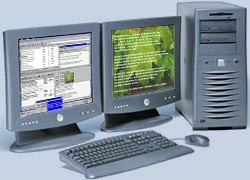| · | Single Screen: The playlist can still be shown on a single screen system, but it naturally covers all the other windows. For this reason, a number of simple keyboard commands have been included to fully control the display. For example, the spacebar quickly moves to the next song. In this mode, the program can be quite useful with a portable computer located on the podium or piano, providing full (even searchable) access to the entire database of music, along with a large-font display of the current song. With additional monitors showing the same image, all the musicians and singers can see the same thing, and one person can handle all the page-turning.
|

